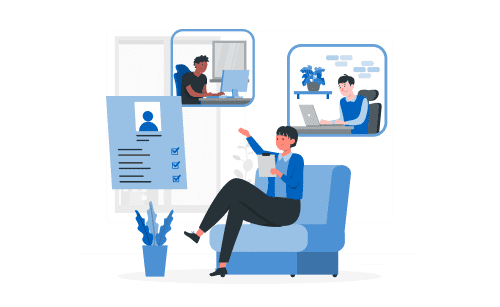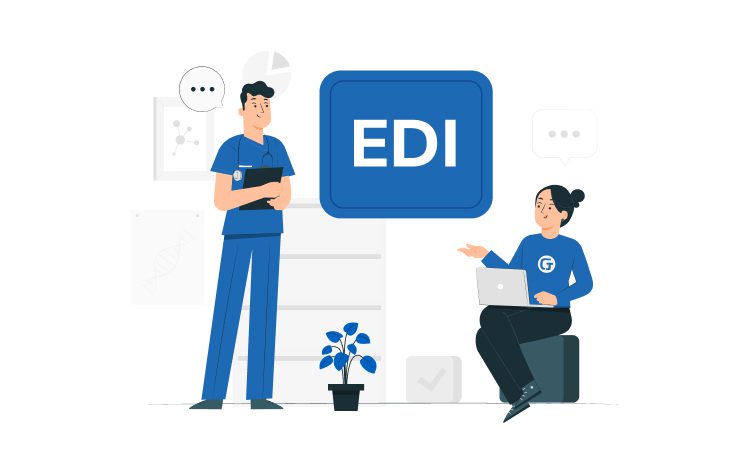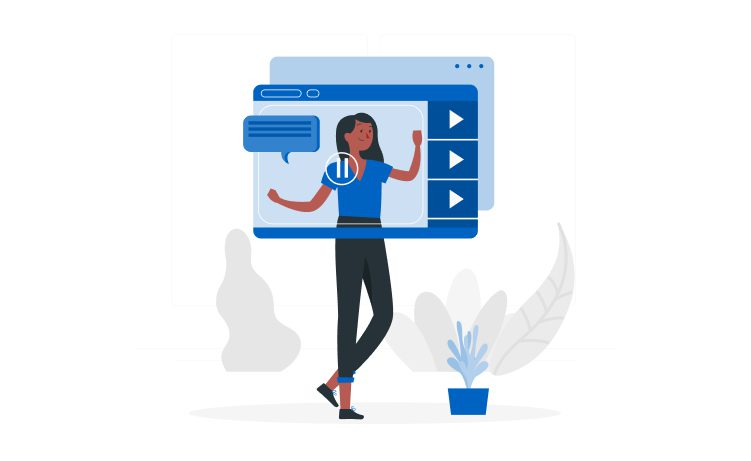
Software Product Development Guide: Steps, Models, and Implementation



In the ever-evolving world of technology, the journey of software product development can seem like traversing through a labyrinth with twists and turns. However, this journey doesn’t have to be intimidating or overly complex, especially when you have a comprehensive guide to navigate you through it.
This article will discuss the process of software product development, along with its steps, models and methodologies.
Content
Software product development is the comprehensive process of creating a new software product or enhancing an existing one.
However, the definition only scratches the surface. To truly understand software product development, we need to delve deeper into its core constituents.
The rapid digital transformation and technological advancements in recent years have made software development an indispensable part of almost every business, irrespective of the industry they operate in. Here are the main reasons why businesses need software development:
As per the purpose, the software is divided into 3 types:
Application programs constitute the most extensive category. They are handy for businesses as they help solve critical enterprise tasks: warehouse management (CTRM /ETRM), customer service (CRM), resource planning (ERP), content management (CMS).
Glorium Technologies has created various software development projects. Here are some examples of Glorim case studies.
Whether it’s a mobile app, a web-based software, or an enterprise-level solution, the principles of software product development guide the way from ideation to deployment and beyond.
Every software has a life cycle, or, the stages that a product goes through from its initial conception as an idea to its implementation and distribution.
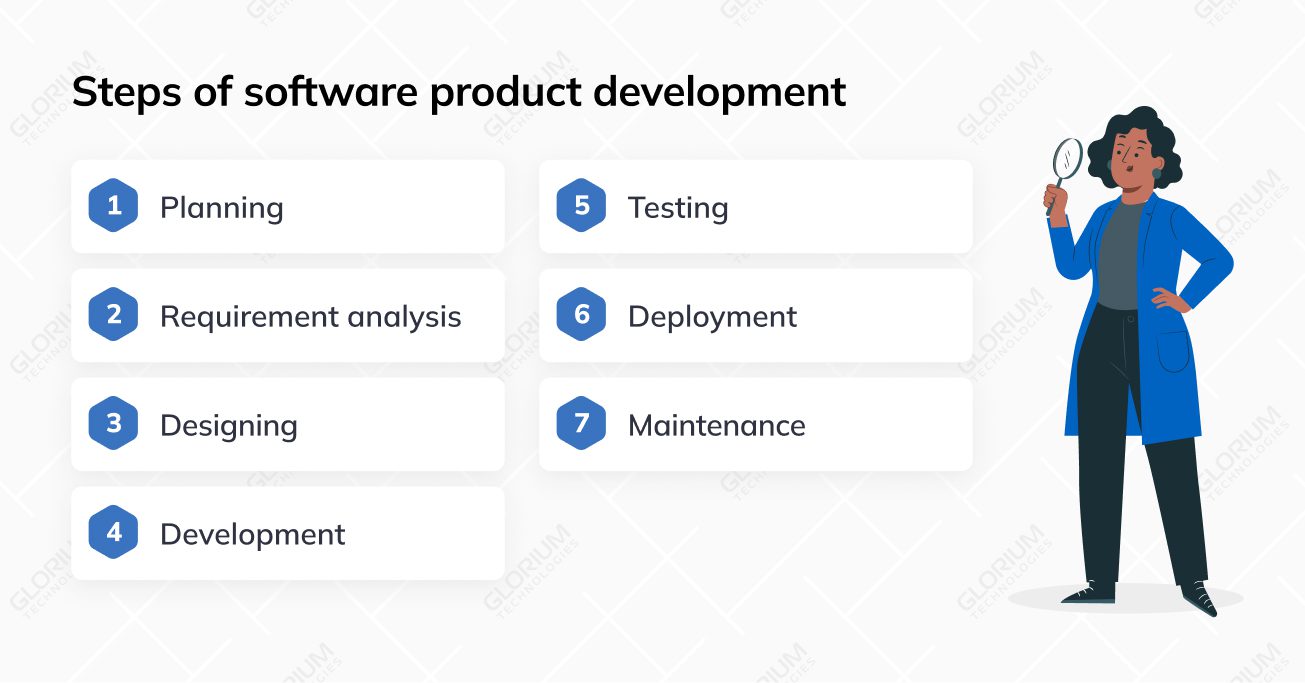
Let’s dive a little deeper into each of these stages.
This is the first stage of the software product development process. It is the most critical stage as it determines whether or not to start developing a particular system.
During the planning phase, teams define system requirements, project schedules and define their goals. The stage can also specify any issues pertaining to an existing system and conditions for its improvement.
Software development depends mainly on planning. It helps figure out what resources are needed and approximate a timeframe, budget, personnel, and any technical aspects for successful project implementation. Lastly, the planning stage outlines potential security concerns, i.e., threats and overall system constraints.
This second stage includes analyzing the system’s functional requirements and how they will meet the needs of users. During the phase, teams should gather and analyze the customer requirements and prepare a Software Requirement Specification (SRS) document. It contains information about the system with functional requirements.
Testing specialists often participate in the discussion to introduce their recommendations and, if necessary, adjust the software product development process.
Read more about how to choose a tech stack for your startup.
During the design phase (also called the design and architecture phase), programmers and system architects, guided by requirements, develop a high-level system design.
Stakeholders and invited prospective customers discuss various technical issues arising during the design process. They determine the project’s technologies, team workload, constraints, timeframes, and budget. In the end, the stakeholders select a design solution that best fits their requirements.
The approved software product development design determines the list of software components to be developed, interaction with third parties, functional characteristics of the program, the databases used, and much more. Design, as a rule, is enshrined in a separate document — a Design Specification Document (DSD).
At this stage, to simplify the visualization of the design process, so-called notations are used — a schematic expression of the characteristics of the system being developed. The main notations are: block diagrams, ER diagrams, UML diagrams, and Layouts – for example, a website prototype drawn in Photoshop.
During software development, the project team needs a dedicated process to organize every development step. Many project management methodologies are used in the software development process, such as Waterfall, Agile itself or Agile subsets (Scrum and Kanban).
Each of these methodologies has its strengths and limitations. Agile is particularly suitable when the project requirements are expected to evolve or need to be fully defined initially. There’s a need for frequent communication and close collaboration among team members. Quick adaptations to changes are necessary, and iterative testing and improvement are part of the project scope.
Kanban is ideal for teams that have a continuous workflow and require flexibility. Kanban works well when the focus is on continuous delivery without overburdening the team members. The project involves the maintenance or continuous improvement, where work items need to be handled as they arise.
Waterfall, as a linear approach to software development, is a suitable choice when the project is well-defined and requirements are likely to stay the same. It is short, and there’s a clear understanding of the outcome from the start. The project only requires a little customer involvement during the development process.
Oleg KumkoProject manager, Glorium Technologies
Agile is a popular project management and product development approach, particularly prominent in software development. It values adaptability and responsiveness to change, emphasizing continuous improvement, customer feedback, and iterative progress, allowing for high-quality software delivery that aligns with customer needs and market realities.
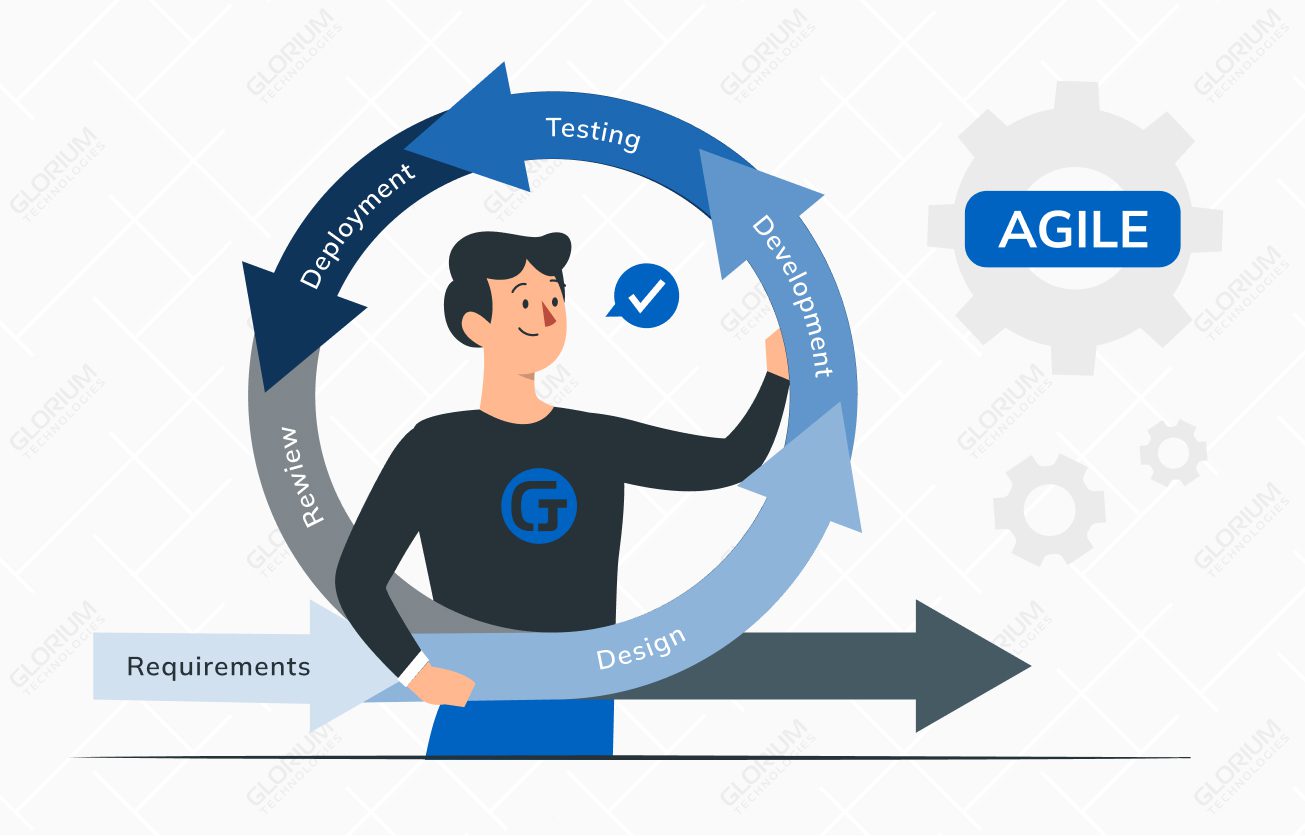
Testers search for bugs in software and compare the system’s work, defined during the requirements analysis stage, with what is actually done. During the testing phase, QA engineers discover bugs missed during the SaaS application development process.
If they find a defect, the tester draws up a bug report and sends it to the developers. The latter fixes it. Then, QAs repeat the testing procedure. However, in the time it takes to ensure that the problem has been fixed, the fix itself must be checked to ensure it did not create new problems in the product.
If users find some post-release bugs, they report them to the development team. Depending on the severity of the problem, the development team has two options: immediately release a fix (the so-called hot-fix) or postpone the fix until the next version of the program.
It is almost impossible to complete the deployment stage in one step. Development teams usually divide software product development release into several phases. Each includes adding new features and making updates and fixes to existing ones based on usage analytics and client feedback.
After that, you can extend the pool to a larger circle of users until it is accessible to your entire audience.
This is the final stage of the software product development process. The maintenance stage starts when the project is successfully implemented and installed in the end-user environment.
The main idea of this stage is to provide regular support to the system and add any new requirements or necessary updates.
This phase ensures that the program is fully functional, improves the software, and updates the system. Software developers should monitor the system and add the latest security measures to protect the program from cybersecurity threats.
The Minimum Viable Product (MVP) approach has taken center stage in software development, especially in the startup ecosystem. Essentially, an MVP is the most basic product version that can still provide value to the user and provide feedback to the company. But how does this approach make software development more efficient?
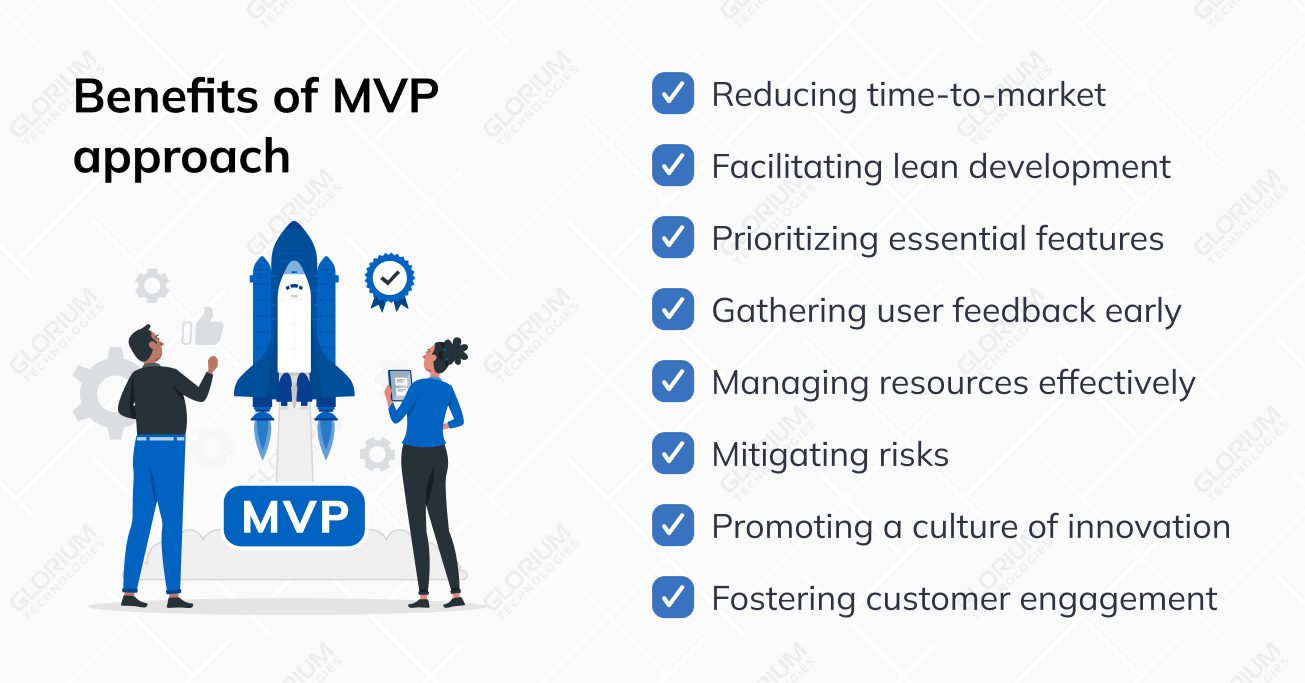
The MVP approach allows businesses to launch a product quickly, as it focuses on building and delivering a product with just enough features to satisfy early users. This significant reduction in time-to-market allows businesses to take the lead in capturing market share and staying ahead of competitors.
The MVP model follows the principles of the Lean Startup methodology, a popular approach in modern software development. It encourages creating a simple product to test the market, measuring its performance, learning from it, and iterating. This iterative development process, facilitated by the MVP approach, minimizes waste, increases productivity, and keeps the project aligned with market needs, making the entire software development process more efficient.
The MVP approach focuses on identifying and developing the most essential features that solve a problem for users. It helps the development team prioritize tasks and prevents them from getting sidetracked by less crucial features. Consequently, the development process becomes more streamlined and efficient.
Releasing an MVP allows businesses to gather valuable feedback from real users early in development. Understanding user needs, expectations, and pain points can guide the development of future product iterations. This early feedback can prevent costly detours and keep product development focused and efficient.
Developing a full-featured software product requires significant time, money, and human resources. By first focusing on developing and launching an MVP, businesses can effectively manage their resources, investing only in features and elements that provide real value to users. It saves resources and increases efficiency as the team is not spread thin working on non-essential features.
Every new product has inherent risks, including market acceptance, technical feasibility, and competition. The MVP approach helps mitigate these risks by validating assumptions about the product and market early in development. This early validation can prevent the wastage of resources on a product that may not succeed in the market, thereby improving overall development efficiency.
An MVP is an initial step in a continuous journey of learning and improvement. This approach encourages a culture of innovation within the development team. As they receive feedback, they can experiment with new features and improvements, fostering an environment of continuous learning and innovation.
By launching an MVP, businesses can engage with their customers from the early stages. This early engagement not only aids in collecting valuable feedback but also helps build a loyal customer base. This interaction can guide the direction of the product, ensuring the development process is efficient and focused on delivering customer value.
So it’s a customer-centric approach that puts user feedback at the heart of software development, ensuring that the final product meets market needs and provides real value to users. Additionally to the MVP approach, outsourcing software development is highly effective. It provides businesses access to specialized expertise and resources they may need in-house.
In the dynamic business landscape, technological competency is a critical determinant of success. However, maintaining a full-fledged in-house software development team might not be feasible or cost-effective for every business, especially startups and SMEs. That’s where software development outsourcing enters the equation, providing access to global talent, technological expertise, and cost savings. So, when does your business need software development outsourcing?

Read more about outsourcing benefits and challenges.
Globally recognized companies have already effectively used outsourcing as part of their business strategy. Opera, the web browser, outsourced the development of its platform for different operating systems and devices. This move allowed the company to speed up its development process and meet the varying needs of its global user base. Another example is GitHub, a leading software development platform, initially relied on several remote contractors before it became a global enterprise.
Outsourcing allowed GitHub to access global talent and scale rapidly. Getting access to expert talent, cost savings, scalability, or risk mitigation, outsourcing can be a game-changer for businesses in their digital transformation journey.
Choosing a reliable software product development company is a critical decision that can significantly impact your project’s success. Selecting the right partner involves more than just assessing their technical capabilities; it’s about finding a company that aligns with your business goals, understands your project requirements, and can deliver high-quality results on time.

Start by clearly defining what you want from your software product. This includes its primary features, target users, platform (mobile, web, or both), and integration with other systems. Consider future aspects, too, like scalability and potential new features.
Evaluate the technical proficiency of potential partners. Check whether they have experience in the technologies and frameworks that your project requires. Their team should include skilled developers, UX/UI designers, QA testers, and other specialists necessary for successful product development.
A company’s past work speaks volumes about its capabilities. Reviewing their portfolio will give you insights into their expertise, creativity, and the complexity of projects they can handle. Also, try out some of the products they’ve developed to assess usability, design, and overall quality.
Check the experience of a software outsourcing company in your industry. A partner familiar with your industry will understand the unique challenges, compliance requirements, and customer expectations better, which can contribute to the product’s success.
Check online reviews and ask for client references. Feedback from previous clients can provide valuable insights into the company’s reliability, communication, quality of work, and problem-solving capabilities.
Effective communication is critical for successful project execution. The company should be able to communicate clearly and promptly. Also, consider the tools they use for collaboration, their responsiveness, and their understanding of your feedback and queries.
Your engagement with the company doesn’t end with product delivery. You’ll need their support for maintenance, troubleshooting, and adding new features. Ensure that the company offers post-development support and services.
Understand the company’s pricing model. Do they charge per project, per hour, or do they have a dedicated team model? Remember, the lowest quote may not always provide the best quality. Look for a partner that offers a good balance of cost and quality.
Inquire about the company’s measures to protect your data and intellectual property. They should comply with international security standards and sign a non-disclosure agreement (NDA).
A reliable partner will not just deliver a high-quality product but also guide you through the process, offering their insights and expertise to enhance the product. With the right partner, any business can transform the idea into a successful software product that offers value to its users and drives business growth.
We offer services that span the entire software development lifecycle, from concept to deployment.
Glorium is committed to delivering high-quality software solutions that drive business success. We strive to provide services tailored to these needs. Our expertise spans multiple industries and technologies, enabling us to deliver versatile and robust software solutions. Contact our managers today and let’s build something amazing together!
Software product development involves designing, programming, testing, and maintaining a software product that is intended to be sold to end-users. This process includes identifying market needs, defining product requirements, developing the software, testing it, and deploying it in the market.
The time taken for software product development depends on the complexity of the product, the technologies used, the expertise of the development team, and the methodologies employed in the development process. It could range from a few weeks for a simple product to several months or even years for a complex, large-scale software product.
The software product development process generally includes the following stages: Idea generation and market research, defining product requirements, designing the software, developing the software, testing the software, deploying the software, and maintaining and updating the software.
An MVP, or Minimum Viable Product, is a version of a product that has features to satisfy the customers and provide feedback for future product development. It is a lean approach that allows for rapid market testing and reduces the risk of failure.
Software product development is crucial as it helps businesses to automate their processes, improve efficiency, and provide better services to their customers.
A competent software product development team should possess a mix of technical skills (like programming languages, database management, and system design), project management skills, problem-solving abilities, understanding of user experience (UX) design, and a deep knowledge of the industry they are developing software for.
Ensuring software quality involves a mix of robust design, thorough testing, and continuous maintenance. Incorporating a strong quality assurance process within your software development life cycle is critical. This involves functional testing, performance testing, security testing, and usability testing.
User Experience (UX) is vital in software product development. A product with a positive UX is easy to use, meets user needs, and creates customer satisfaction. It’s essential to incorporate UX design early in the development process and to continuously test and refine it based on user feedback.
Yes, outsourcing Software Product Development is a common practice. It can provide access to global talent, reduce costs, and speed up the development process. However, it’s important to choose a reliable outsourcing partner to ensure the quality and success of your software product.

